
Morningside University is a private university affiliated with the United Methodist Church and located in Sioux City, Iowa, United States. Founded in 1894 by the Methodist Episcopal Church, Morningside University has 21 buildings on a 68-acre (280,000 m2) campus in Sioux City. The Morningside College Historic District, which includes most of the campus, is on the National Register of Historic Places. Morningside College officially became Morningside University on June 1, 2021.
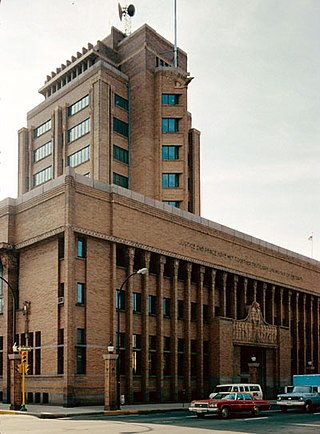
William LaBarthe Steele was an American architect from Chicago, Illinois. He is considered a principal member of the Prairie School Architectural Movement during the early 20th century.

The National Florence Crittenton Mission was an organization established in 1883 by Charles N. Crittenton. It attempted to reform prostitutes and unwed pregnant women through the creation of establishments where they were to live and learn skills.
National Crittenton is a Portland, Oregon-based American organization that works with at-risk and criminal justice system-involved girls, young women and their families. The foundation is affiliated with 25 member agencies operating across the country in urban and rural areas, including Baltimore; Boston; Charleston, South Carolina; Denver, Colorado; Kansas City, Missouri; Knoxville, Tennessee; Orange County, California and Los Angeles, California; Peoria, Illinois; Philadelphia; Phoenix, Arizona, San Francisco, California; Sioux City, Iowa; Washington, D.C., and Wheeling, West Virginia.

Kate Waller Barrett, née Katherine Harwood Waller, was a prominent Virginia physician, humanitarian, philanthropist, sociologist and social reformer, best known for her leadership of the National Florence Crittenton Mission, which she founded in 1895 with Charles Nelson Crittenton. Her causes included helping the "outcast woman, the mistreated prisoner, those lacking in educational and social opportunity, the voteless woman, and the disabled war veteran." Although comparatively little known today, she was "[o]ne of the most prominent women of her time".
Florence Crittendon Home may refer to:

Clarissa Cook Home for the Friendless is a historic building located in the west end of Davenport, Iowa, United States. It was listed on the National Register of Historic Places in 1983.

St. Luke's Hospital was a hospital building on a bluff overlooking downtown Davenport, Iowa, United States. It is listed on the Davenport Register of Historic Properties and the National Register of Historic Places. It has subsequently been torn down.

Mount Sinai Temple is an historic former Reform synagogue located in Sioux City, Iowa, in the United States. The building was listed on the National Register of Historic Places in 1999.
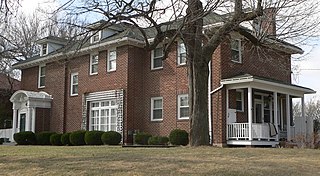
The Sanford House, also known as the Stone House and Summit Mansion, is a historic residence in Sioux City, Iowa. Throughout the 1990s, it was commonly referred to as the “Home Alone house” in reference to the similar looking neocolonial residence featured in the eponymous film that had become a pop culture phenomenon.

The Dickinson County Courthouse is located in Spirit Lake, Iowa, United States. Built in two phases in 2006 and 2009, it is the fourth building to house court functions and county administration.

Beuttler & Arnold was an architectural firm in Sioux City, Iowa that designed several works that are listed on the National Register of Historic Places for their architecture.
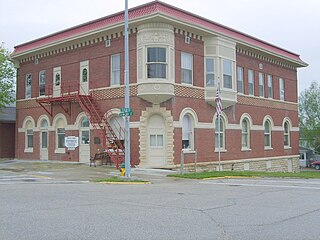
Maple View Sanitarium, also known as Community Hospital, Good Samaritan Nursing Home, and the Fayette County Historical Center, is a historic building located in West Union, Iowa, United States. It was built by Dr. Frank Beach Whitmore in 1903. The facility could accommodate 12 to 15 patients, it had its own operating room, and office. There was also a general store located in the commercial space on the main floor. Because medical care in a hospital was new in the community, it did not succeed and it folded in 1905. Whitmore left to become a missionary in China. The building housed professional offices and retail businesses until 1914 when the Nurses' Benevolent Association under the auspices of the Seventh-day Adventist Church bought the building for a hospital. It was more successful as a hospital the second time, and it was acquired by the city for a community hospital in 1920. After a new hospital building was constructed in 1951, the Good Samaritan Society bought the building for a nursing home. By 1973 changes in state law no longer made operating a nursing home here feasible. The Fayette County Historical Society acquired the building in 1975 for its use, and it operates a local history museum in the building. It was individually listed on the National Register of Historic Places in 1998. In 2015 it was included as a contributing property in the West Union Commercial Historic District.
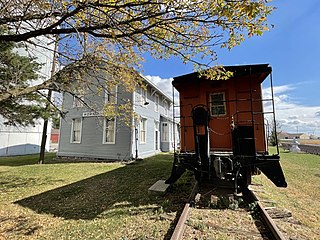
The Chicago, Milwaukee, St. Paul & Pacific Combination Depot-Hornick, also known as the Hornick Depot, is a historic building located in Hornick, Iowa, United States. The town was patted by the Chicago, Milwaukee, St. Paul & Pacific Railroad's land company when the railroad created a branch line from Manilla, Iowa to Sioux City. Completed in 1887, the railroad built this two-story frame structure to serve as its passenger and freight depot. It is one of six such depots that remain in Iowa, and the best preserved. These buildings were built from a standard design used by the railroad. The two-story stations included living quarters for the station manager because the towns had yet to develop when the depot was built. This was an island depot, with freight loaded on the north side and passengers boarded on the south. Decorative elements on this depot include lathe-turned wooden finials, angled wooden brackets, and bracketed door and window hoods. Passenger service ended in the 1950s, and grain was loaded here until 1980 when the Milwaukee Road abandoned the Sioux City branch line. The building was listed on the National Register of Historic Places in 1990. It has been converted into a local history museum.

The Sioux City Public Library-North Side Branch, also known as Bruce Meyer Productions, is a historic building located in Sioux City, Iowa, United States. The city received a total of $85,000 in 1911 from Andrew Carnegie to build the main library and the Leeds branch library. It was the only city in Iowa to receive a grant for both a main and branch library. A $100,000 bond issue passed in 1926 to replace the temporary facilities for the other branch libraries throughout the city. The North Side Branch was designed by local architect William L. Steele in the Tudor Revival style, and was completed in 1929. It was used as a branch facility until 1982 when the city closed all of the branch libraries in 1982, except the Morningside branch. A new branch library was created on the north side. The old north branch was sold to Bruce Meyer for his photography studio. It was listed on the National Register of Historic Places in 2000.

The Lewis System Armored Car and Detective Service Building, also known as the Bell Tire and Rubber Company (Service Company) and Sioux City Tent and Awning, is a historic building located in Sioux City, Iowa, United States. F.A. Martin and Richard Nash, who owned the property, had this two-story brick commercial building constructed in 1929. KB Construction (Federation Construction Company), who built the building, occupied the second floor. Bell Tire and Rubber Company was the first business located on the first floor from 1930 to 1933. A few other businesses occupied the space until Sioux City Tent and Awning was located here from 1937 to 1941. The following year Lewis System moved in and remained until 1969. The second floor was converted into apartments about 1950.
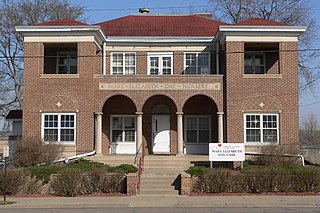
Mary Elizabeth Day Nursery, also known as Mary Elizabeth Day Care Center, is a historic building located in Sioux City, Iowa, United States. This is the oldest child day care facility in the state of Iowa, and the state's second-oldest preschool. The Sioux City Day Nursery was established in 1914 by the Wall Street Mission, a local settlement house operated by the Methodist Episcopal Church. They moved here in 1926, which is the first building designed as a day nursery in Iowa. The two-story brick Renaissance Revival building was designed by local architect Jurgen A. Raven, and built by The Lytle Company, a Sioux City construction firm. Parents were responsible for paying for at least part of their children's care, but it was also subsidized by religious institutions, private associations, and individuals. During the Great Depression, both the federal and state governments began to fund and license child care. The Works Progress Administration was involved in the 1930s. A garage and playhouse designed by Sioux City architect Knute E. Westerlind was built in 1940, and it is part of the historic designation. The facility was renamed the Mary Elizabeth Day Care Center in 1990. The building was listed on the National Register of Historic Places in 1997.
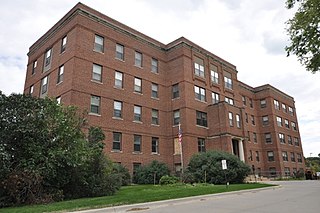
Sacred Heart Hospital, also known as the Floyd Valley Apartments, is a historic building located in Le Mars, Iowa, United States. Construction of the building began in 1921. It was designed by Sioux City architect William Steele and Riesche & Sanborn was the contractor. The five-story brick structure was completed two years later for $350,000. The Sisters of St. Francis from Dubuque operated the hospital for the next 43 years. In addition to the hospital, the building also housed Sacred Heart Nursing School from 1923 to 1938. On December 1, 1966, the City of Le Mars took over the operation of the hospital, which was renamed Floyd Valley Hospital at that time. They continued to use the Sacred Heart building. A capital campaign to build a new facility was begun in 1972, and the present hospital on Iowa Highway 3 was completed in 1976. This building has subsequently been converted into apartments. It was listed on the National Register of Historic Places in 2010.

Albertson and Company-Rocklin Manufacturing Company is a historic building located in Sioux City, Iowa, United States. Completed in 1912, the building initially housed Automatic Valve Seating Mach Co. They reorganized in 1914 and became the Sioux City Machine and Tool Company, which produced spark plugs and tire valves. The company failed four months later and the shop foreman, Frans Oscar Albertson, formed Albertson & Co. and took over the plant. During World War I they supplied 6,000 piston rings and repair tools for munition plants for Canada. Albertson never owned the building and moved his operations to another Sioux City building in 1920. The company went on to become the largest manufacturer of portable electronic and air tools in the world. They changed their name to Sioux Tools Inc., and in 1993 they became a division of Snap-On Tools. Their manufacturing facility moved to North Carolina in 2001.




















